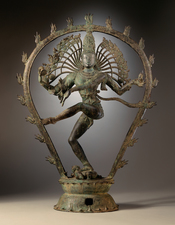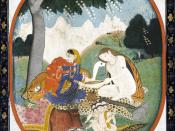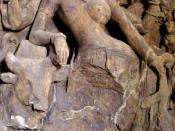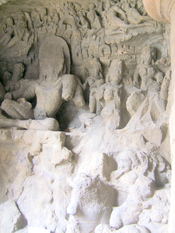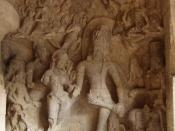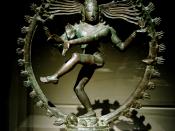Standing Mahadeva Indian art is based on gods and goddesses of India. The only proof of the existence of the god is the sculptures, which have been carved by the people for thousands of the years. These sculptures tell us the story of the gods and goddesses. The stones are the storytellers, which are now found in temples, caves, monuments, and museums. The Cleveland museum of art includes a remarkable image of standing Mahadeva. It represents Shiva, one of the great Hindu deities, as Mahadeva, one of his manifestations. This image is a grey schist murti, or sculpture found in Kashmir. This sculpture is from the 8th century B.C.E.
In the museum icon Mahdeva is standing with his two sons Kartikeya and Ganesha. Kartikeya is on the left side of Shiva. Kartikeya, the elder son of Lord Shiva, is also known as Subramaniam and represents a person of perfection.
He has taken birth to destruct the demon Taraka sur . It seemed that the two (Shiva and Parvati ) were constantly making love, to the discontent of the other gods. Gods were concerned that their offspring might be too powerful. Finally they were persuaded to stop, but there was much of Shiva's seed, which had not been used. This was burning hot and no one could hold it. It was passed from god to god until it finally was tossed into the sacred waters of the Ganges. Shiva took the seed and placed it on top of a mountain for ten thousand years in the sight of the rising sun, and Kartikeya was born. The Krittikas (the six stars of the Pleiades) took his care, from which he got his name. In one hand, he carries a spear called Shakti, which symbolises the destruction of demons. With his other hand he always blesses devotees. His vehicle is a peacock, which is capable of destroying harmful serpents (symbolizing harmful ego and bad desires of people). He usually wears claws of the tiger in his neck, to suggest bravery. In this image, he has the claw necklace, the spear, and his vehicle peacock. He has four hands. Gods usually have four hands to show that they have more strength then a normal person.
Ganesha is on the right side of the Shiva. Ganesha, the youngest son of Shiva, is the god of knowledge and remover of obstacles. Lord Ganesha is also called Vinayak (kowledeable) or Vighneshwer (god to remove obstacles). He has elephant's head and a big belly. The story behind it was: Once Shiva went in a forest for meditation. At that time Parvati gave birth to Ganesha. One day Parvati was taking bath and Ganesha was guarding the door. At that time Shiva suddenly came back, as Ganesha didn't know his father he didn't allow him to enter in the house. For that reason Shiva got angry and cut off his head. In the meantime Paravti came out from her bath and was aghast at the scene. She was very angry at her lordship for what had happened and explained to him the situation. Shiva sends his trident with orders to take the head of whoever comes first in its way. And an elephant comes tridents way and so Ganesha gets an elephant's head. Parvati was still not totally happy with the deal and wanted more. Then Shiva granted Ganesha a boon that before beginning any undertaking or task people would worship Lord Ganesh. Thus the reason there is worship of Ganesha before start of any work. His vehicle is a tiny mouse. In his hands he carries a rope (to carry devotees to the truth), an axe (to cut devotees' attachments), and a sweet dessert ball -laddoo- (to reward devotees for spiritual activity). His fourth hand's palm is always extended to bless people. In this image he has sweets in one hand, and by his other hand he is blessing. He has a big stomach and only one tusk. This is a very fine carving, which shows us the smiling face of Lord Ganesha.
Shiva is the god of destruction. Yet he was greatly loved, because death is simply a stage in the cycle of creation and represents release and rebirth. So Shiva was also called 'Mahadeva', which means the restorer as well as destroyer. Shiva is always beautiful with a light skin and a third eye on his forehead, which has terrible power when Shiva becomes enraged. When the world was being created the many things that were to live in it were thrown up form the churning ocean.
The first thing that came out of the ocean was the divine cow Surabhi, whose son Nandi , a snow-white bull, later becomes the vehicle of Shiva. The sculpture at Cleveland Museum has a Nandi standing behind Shiva. In this image Nandi is being dressed up with jewellery, which includes a crown.
Second thing that came out of the ocean was the crescent moon, which he snatched from the waves and placed on his forehead to decorate his hair. On most sculptures and pictures of Shiva, this moon is scene. In this image, also there is a crescent moon in his hair.
The third thing that came out of the ocean was the poison. It was the deadliest poison. Even the smell of it can kill a person. Shiva drank this poison in order to save the world from its harm. Instead of swallowing it, he held it in his neck, and the poison turned his neck blue. The snake around his neck represents the poison he has drunk. This sculpture has a snake running down from his left shoulder.
Along with these basic things, Shiva looks more beautiful with the jewelry. Jewelry includes necklaces, arm bands, bracelets, finger rings, toe rings, and anklets. All figures in this sculptures wear crowns, which are marvelously carved. They are usually clothed in short trunks and jewels.
Shiva has three faces. On the left is the terrifying face, which shall be of Bhairava. That is a terrifying face of Shiva. Usually the Bhairava form of Shiva has four hands. Each one of those hands carry a bowl (to collect the blood of the demon), the trident, the sword, and a mini drum. On the right is the polite face, which shall be of Uma. Uma is the personification of light and beauty. She is the Devi (goddess) allotted to Shiva. This form shows us a very friendly and a polite form. Usually Uma looks at her face in a mirror. Here also she is looking at her beauty in the mirror. In the middle is the face of Shiva, who is beyond any emotions. He has no expressions on his face.
According to my grandfather, this sculpture shows us three essences of life, which are Rajas, Tamas, and Satva. Here Rajas is the stage where there is all type of enjoyment, which includes sex, money, and popularity. Tamas is the stage where there is anger, greed, desire, etc. Finally, Satva is the stage where there is no greed, no anger, no desire for sexual life, etc. This stage is beyond every thing. This stage leads a person to Moksha . According to my grandfather, Shiva shows us, in this image, that the Satva is the best form. Secondly, he said that for obtaining Moksha, Kama and Krodha , are the two main obstacles. Here Kama is shown in the left, and Krodha is shown in the right. Middle face says Dharma or holiness, which is essential for Moksha. Lord Shiva gives this advice, by showing us his three faces.
Similar to this type of murti is found in Elephanta caves near Bombay. The famous Maheshamurti lies deep, in the inner corner of the cave.
Here also three forms of Shiva are shown which are terrifying, impassive, the eternal Shiva. Thus, Shiva is considered as the supreme Lord, the eternal.
The sculpture is very well carved. The stone, which is used, is very fine grain. Fine details of the image make it attractive. Carving is very defined.
Works Cited Introduction to Hinduism.
http://geocities.com/RodeoDrive/1415/indexd.html Tourism in India-exotic places- Elephanta Caves, Discover India.
http://www.indiagov.org/tourism/exotic/elephanta.htm Demons, Gods and Holy Men, Shahrukh Husain, 1987.
Amar Chitra Katha.
http://www.freeindia.org/ack/Ganesha/
